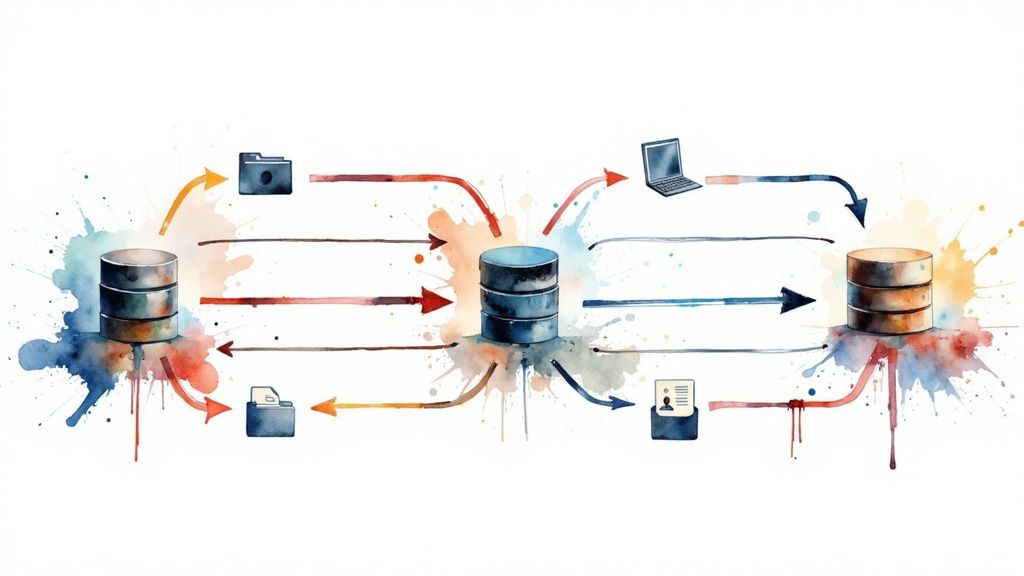Your Gut Is Lying To You. Here's How To Prove It.
Discover key strategies for successful business intelligence implementation to drive growth. Read our comprehensive founder's guide today!
Posted by
Related reading
Stop Guessing. Your Gut Feeling Is Killing Your Business.
Stop guessing. Learn how measuring client satisfaction drives growth. This founder's guide offers real strategies to get honest feedback and act on it.
Your Gut Feeling Is Probably Wrong. Here's What to Do About It.
Learn what is data driven decision making and why it's the key to startup survival. Ditch gut feelings for hard data and build a business that actually wins.
Your Founder's Guide to Primary Market Research
Stop guessing and start building. This guide to primary market research gives founders the tools to validate ideas and build products customers actually want.
Let’s be honest. Half the "data-driven" founders I meet are just dressing up their gut feelings in fancy charts. They buy a BI tool, hook up Google Analytics, and stare at a vanity metric that goes up and to the right, feeling like a genius. It’s a joke.
Real business intelligence isn't about looking smart. It's about finding the ugly, expensive truths you've been avoiding. It's the process of forcing your company to stop guessing and start knowing.
Think of it as installing a truth-telling machine in your office. And trust me, the truth usually stings.
Your Gut Is a Bankrupting Liability
You think you know your business. You feel the pulse of the market. With all due respect, you're high on your own supply.
Every founder has a "sure thing" feature that ate six figures of payroll and landed with a thud. The line between a unicorn and a dead donkey isn't genius—it's having the right data.
I learned this the hard way. We were convinced our most active users were our best users. Our whole team felt it. We burned cash on features they begged for. Our gut, our intuition, even our user interviews screamed, "This is the way!"
Then we finally connected our product analytics to our Stripe data. The reality was a punch to the gut.
Those "power users"? Almost all on a legacy free plan, bleeding our servers dry and contributing zero revenue. Our actual paying customers were quietly using one boring, simple feature. We were actively building for the wrong people, burning cash to please users who would never pay us.
Our gut feeling was driving us straight toward bankruptcy. A pivot fueled by two simple, connected data points was the only thing that saved us.
The Wake-Up Call You Can't Snooze
This isn't just a war story; it's a fundamental law of startups. Your gut is for hiring decisions and smelling bullshit in a pitch. It is not a tool for allocating capital. Relying on it is like trying to fly a 747 blindfolded because you "have a good sense of direction."
This is why a real business intelligence implementation has gone from a 'nice-to-have' for suits to a core survival tool for founders. The market simply doesn't care about your hunches.
Look at the numbers. The global BI market is set to hit $116.25 billion by 2033. This isn't a trend; it's an arms race. A staggering 95% of professionals admit analytics are vital. Ignore this, and you're bringing a PowerPoint to a gunfight.
Let's pit your gut against the cold, hard numbers.
Gut Feeling vs. BI-Driven Decisions
| Founder's 'Gut Feeling' | What the Data Actually Shows | The Brutal Consequence of Being Wrong |
|---|---|---|
| "Our most active users are our most valuable customers." | Your highest-paying cohort logs in twice a month to use one specific report. | You waste R&D building features for freeloaders while your real customers churn in silence. |
| "This marketing channel feels like it's crushing it." | It has high vanity metrics (clicks, likes) but a near-zero conversion rate. | You pour your budget into a black hole while a less sexy but higher-converting channel starves. |
| "Everyone wants this new, complex feature!" | 2% of users touch it, and it's causing 30% of your support tickets. | Your product becomes a bloated, buggy mess, frustrating the silent majority who just want the basics to work. |
The gap between what you think and what is true is where companies die. Thinking you can out-maneuver this is pure hubris. You need a system that surfaces the unfiltered truth. The first step is often to streamline business processes using AI automation, so your data isn't garbage from the start.
Takeaway: Your gut is for reading people, not P&Ls.
Stop Chasing Unicorns—Build a Go-Kart
Let's talk tools. Every time I see a founder drooling over some six-figure, enterprise-grade platform, I want to shake them. You are not a bank. You are not a logistics empire. You are a startup held together by caffeine and duct tape.
Your goal with a business intelligence implementation isn't to build a perfect, gleaming Formula 1 car. Your goal is to build a go-kart. A scrappy, ugly go-kart that wins you the race today by answering one painful question. Forget the shiny features and the smooth-talking sales reps.
Most founders get paralyzed by choice or seduced by complexity. They spend months “evaluating” when they should be getting answers. Before you look at a single demo, you need to answer three brutally simple questions. Get these wrong, and your BI project is dead before it starts.
The Only Three Questions That Matter
- The "Oh Sh*t" Metric: What is the one metric that, if it tanked overnight, would make you cancel your vacation and call an emergency meeting? Daily active users? CAC? Gross margin? Don't say "revenue"—be specific. This is your North Star. Your BI tool must track it flawlessly.
- The "Idiot-Proof" Audience: Who really needs this data? Just you? Your Head of Sales? If they can barely manage a pivot table, don't buy a tool that requires SQL. The most beautiful dashboard is useless if the people who need it are too scared to log in. Design for the most impatient, least technical person in the room.
- The "Good Enough" Budget: What's your budget in time and money? Is it $500 a month and one engineer's afternoon? Say it. This constraint is your friend. It stops you from chasing enterprise unicorns and forces you to build a workhorse that delivers value now.
This planning stage is where most BI projects fail. This blueprint shows you how to define strategy before you ever touch software.

This isn't just a diagram; it's a reminder that a successful BI tool is built on strategy, not features. To avoid building a project that just delivers invoices, ground your execution with solid principles from mastering data science project management.
Takeaway: Your first BI tool shouldn't do everything; it should do one thing perfectly: answer your most expensive question.
Your Data Is a Dumpster Fire. Light a Match.
Let's start with a universal truth: the first time you look at your company's raw data, you'll feel a wave of panic. It’s a chaotic jumble of inconsistent formats, missing fields, and conflicting information from Stripe, HubSpot, your app's backend, and seventeen different Google Sheets.
Welcome to the club. The mistake isn't having messy data; it's trying to clean it all at once.
You don't need a pristine data warehouse. That’s an enterprise fantasy that will bankrupt you. You need to find the two or three critical data sources that answer your most painful question. Then, you duct-tape them together well enough to get an answer. A core part of any business intelligence implementation is this kind of ruthless prioritization.

This isn't a technical manual. This is a guide to wrestling your data into submission without boiling the ocean.
How to Tame Your Data Dumpster Fire
Forget "data governance." Your job is to find the signal in the noise, fast. Be a pragmatist, not a purist.
- Identify Your Most Expensive Question. Don't ask, "What can our data tell us?" Ask, "What's the one question we can't answer that's costing us money?" Is it "Why are our best customers churning?" or "Which marketing channel actually brings in paying users?" Start there.
- Find the Minimum Viable Data. What are the absolute fewest data sources you need? For our revenue problem, it was just the users table and the Stripe payments table. Not HubSpot. Not Google Analytics. Just two.
- Connect, Don't Perfect. Use a modern tool with built-in connectors to pull the data together. It will be messy. It doesn't matter. You're looking for a directional answer, not a peer-reviewed paper.
That one, ugly, duct-taped connection saved us from a six-figure mistake. That’s the power of starting small. Prove the value first. Clean up later. This process often surfaces powerful qualitative insights, too. As you dig into who your best customers are, you can also dig into why with a focused approach to Voice of Customer analysis, adding the story behind the numbers.
Takeaway: Your first data project isn't about building a palace; it's about building a raft to get off a burning island.
Your Dashboard Is a Graveyard Where Data Goes to Die
Most BI dashboards are useless. They're cluttered, confusing digital canvases built for admiration, not action. They're packed with every metric someone thought was “interesting” during a brainstorm.
The result? A useless mess your Head of Sales glances at once, gets overwhelmed by, and never opens again. This is where your entire business intelligence implementation falls apart—not in the data warehouse, but on the screen. Stop building dashboards that look like a Jackson Pollock painting and start building ones that work like a pilot's cockpit.
The mistake is building dashboards to display data. You need to build them to answer questions.
The "One Question, One Chart" Rule
This is it. The only rule that matters. Every chart on your dashboard must answer one specific business question. If you can't state the question in plain English, kill the chart.
- Bad: "How are sales?" (Leads to a chart with 12 lines and zero clarity).
- Good: "What is our average sales cycle length for deals over $10k this quarter?" (Leads to a single, un-ignorable number).
A dashboard isn’t a report; it’s a decision-making machine. If your co-founder can't look at it and make a decision in under 60 seconds, you failed.
Killing Your Darlings (and Your Pie Charts)
Building a good dashboard is about what you remove. Be a ruthless editor.
- Vanity Metrics: Total sign-ups, page views. These numbers almost always go up and to the right, which feels great but tells you nothing. Ditch them for cohort analysis or activation rates.
- Pie Charts: Just stop. Unless you are showing how three categories make up 100% of a whole, they are visual garbage. A simple bar chart is always better.
- Data Overload: A dashboard with 20 charts answers zero questions. A powerful dashboard might only have 3-5 core visuals, each focused on a leading indicator of revenue or customer health.
Think of that pilot's cockpit. They see airspeed, altitude, fuel—the critical instruments to avoid crashing. Your dashboard serves the same purpose. Getting it right is what turns all that back-end work—the messy data integration, the tool selection—into tangible value.
Takeaway: Build your dashboard for the most impatient, skeptical person on your team; if they get it, everyone else will.
Make Your Team Argue With Data, Not Each Other
So you've wrestled your data and built a dashboard that doesn't suck. Congratulations. Now for the hard part: getting your team to use it.
If your people ignore the data in favor of their gut, you’ve just built an expensive digital paperweight. Adoption isn't about "training." It's about changing the language of your company. Your goal is to make "I think" an unacceptable phrase in any important meeting. You want to replace it with the far more powerful, "The data shows..."

Make Data the Referee
The win isn't when everyone agrees with the data. The win is when they start arguing with it. When your Head of Marketing and Head of Product are debating a retention chart—pointing at trend lines, questioning the inputs—you’ve succeeded. They’re no longer arguing about opinions; they’re arguing about reality.
Data is the objective third party in the room that doesn't have an ego or a pet project to defend. It just is.
Your job isn't to get your team to love data. It's to get them to respect it enough to fight with it.
How to Force Adoption (Because You Have To)
Culture change is tactical. Force the behavior until it becomes a habit.
- The 5-Minute Data Stand-up: Start key meetings by putting one relevant dashboard on the screen for five minutes. In silence. Let them confront the numbers.
- Data Bounties: Create a Slack channel called
#data-discoveries. Offer a $100 gift card for the first person each month who finds an insight that leads to a documented change. Gamify the hunt. - No Data, No Discussion: Institute a rule: if you’re proposing a new initiative, your first slide must be a chart from the BI system that justifies it. This sidelines the bullshitters.
This isn't about creating more work; it's about making the work more effective. You can apply the same principle to your customers; check out our guide on how to get customer feedback to see how direct input fuels this culture.
The coming AI wave will force your hand. Soon, you won't have a choice. By 2025, AI will be embedded in most applications, moving BI from reactive reporting to proactive analysis. Read up on BI trends on heinsohn.co to see what's coming.
Ignore your customers, and you’ll be lucky to survive the quarter. Ignore the data, and you're already dead.
Takeaway: Stop trying to get your team to "adopt" dashboards and start creating a culture where they can't win an argument without one.
Straight-Up BI Answers for Skeptical Founders
Alright, let's cut the crap. These are the real, unfiltered questions I hear from other founders over beers—the stuff we talk about when the consultants aren't in the room.
How do I know which metrics aren't bullshit?
Stop obsessing over vanity metrics. Total traffic, social media likes, raw sign-ups—that’s digital junk food. It feels good but offers zero nourishment.
Find your one North Star Metric. This is the single number that acts as a proxy for the value you deliver to customers. For a SaaS company, it might be "Weekly Active Users Who Perform a Core Action." For e-commerce, it could be "Customer Lifetime Value."
Acid test: if this metric dropped to zero, would your business be dead? That's your starting point.
Track the one number that proves you're not just a hobby.
Can I do this without a data scientist?
Yes. Anyone telling you otherwise is trying to sell you something expensive.
In the early stages, you aren't doing "data science"; you're doing "data plumbing." Your goal isn't to build a predictive model of the universe. It's to get clear answers to simple questions:
- Where are my best customers coming from?
- Which features are people really using?
- Where's the biggest drop-off in my onboarding?
Modern BI tools are built for business people. You don’t need a Ph.D. You need curiosity and a low tolerance for guesswork. If you do get stuck, consulting experts can offer a quick fix, but don't let that fear stop you from starting today.
What's the biggest mistake founders make?
Trying to boil the ocean. They get a grand vision of connecting every data source—Stripe, HubSpot, Google Analytics, their grandma’s recipe spreadsheet—to build the one "perfect" dashboard.
This is a guaranteed recipe for a six-month, soul-crushing project that delivers zero value.
Instead, do this:
- Pick one painful, expensive problem. Like, "Our customer churn is too high, and we have no idea why."
- Connect only the essential data. You might only need your user table and subscription data. That's it.
- Get a quick, dirty win. Build one simple chart that sparks a real conversation.
Your first BI project should take weeks, not quarters. Its only job is to prove this whole data thing is worth the effort.
Stop guessing what your customers are screaming at you and find out for sure; get ridiculously clear insights from your user feedback with Backsy.ai today.